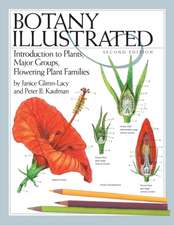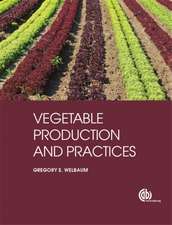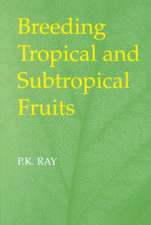Edible Medicinal And Non-Medicinal Plants: Volume 7, Flowers
Autor T. K. Limen Limba Engleză Hardback – 9 dec 2013
Toate formatele și edițiile
| Toate formatele și edițiile | Preț | Express |
|---|---|---|
| Paperback (7) | 846.10 lei 38-44 zile | |
| Springer International Publishing – 20 mar 2019 | 846.10 lei 38-44 zile | |
| SPRINGER NETHERLANDS – 31 mar 2018 | 1100.37 lei 38-44 zile | |
| Springer International Publishing – 30 mar 2018 | 1389.97 lei 43-57 zile | |
| SPRINGER NETHERLANDS – 23 aug 2016 | 1565.79 lei 43-57 zile | |
| SPRINGER NETHERLANDS – 23 aug 2016 | 1611.51 lei 38-44 zile | |
| SPRINGER NETHERLANDS – 23 aug 2016 | 1770.74 lei 38-44 zile | |
| SPRINGER NETHERLANDS – 17 sep 2016 | 1779.80 lei 38-44 zile | |
| Hardback (7) | 1195.26 lei 38-44 zile | |
| SPRINGER NETHERLANDS – 16 feb 2016 | 2174.19 lei 22-36 zile | |
| Springer International Publishing – 25 feb 2016 | 1195.26 lei 38-44 zile | |
| Springer International Publishing – 16 feb 2016 | 1397.52 lei 43-57 zile | |
| SPRINGER NETHERLANDS – mar 2013 | 1587.39 lei 43-57 zile | |
| SPRINGER NETHERLANDS – 3 feb 2013 | 1881.10 lei 43-57 zile | |
| SPRINGER NETHERLANDS – 9 dec 2013 | 2033.27 lei 43-57 zile | |
| SPRINGER NETHERLANDS – 13 iun 2012 | 2141.41 lei 43-57 zile |
Preț: 2033.27 lei
Preț vechi: 2479.60 lei
-18% Nou
Puncte Express: 3050
Preț estimativ în valută:
389.19€ • 422.89$ • 327.13£
389.19€ • 422.89$ • 327.13£
Carte tipărită la comandă
Livrare economică 21 aprilie-05 mai
Preluare comenzi: 021 569.72.76
Specificații
ISBN-13: 9789400773943
ISBN-10: 9400773943
Pagini: 750
Ilustrații: XII, 1102 p. 232 illus., 109 illus. in color.
Dimensiuni: 178 x 254 x 50 mm
Greutate: 2.13 kg
Ediția:2014
Editura: SPRINGER NETHERLANDS
Colecția Springer
Locul publicării:Dordrecht, Netherlands
ISBN-10: 9400773943
Pagini: 750
Ilustrații: XII, 1102 p. 232 illus., 109 illus. in color.
Dimensiuni: 178 x 254 x 50 mm
Greutate: 2.13 kg
Ediția:2014
Editura: SPRINGER NETHERLANDS
Colecția Springer
Locul publicării:Dordrecht, Netherlands
Public țintă
ResearchCuprins
Introduction.- Amaryllidaceae.- Apocynaceae.- Asclepiadaceae.- Asparagaceae.- Asteraceae.- Balsaminaceae.- Begoniaceae.- Bignoniaceae.- Brassicaceae.- Cactaceae.- Calophyllaceae.- Caprifoliaceae.- Caryophyllaceae.- Combretaceae.- Convolvulaceae.- Costaceae.- Doryanthaceae.- Fabaceae.
Textul de pe ultima copertă
This book continues as volume 7 of a multi-compendium on Edible Medicinal and Non-Medicinal Plants. It covers plants with edible flowers whose floral parts including the stalk and flower nectar are eaten as conventional or functional food and may provide a source of food colorant, additive or neutraceuticals. This volume covers plant species with edible flowers from families Acanthaceae to Fabaceae in a tabular form and seventy five such species from the families Amaryllidaceae, Apocynaceae, Asclepiadaceae, Asparagaceae, Asteraceae, Balsaminaceae, Begoniaceae, Bignoniaceae, Brassicaceae, Cactaceae, Calophyllaceae, Caprifoliaceae, Caryophyllaceae, Combretaceae, Convolvulaceae, Costaceae, Doryanthaceae and Fabaceae in detail. The edible species dealt with in this work include wild and underutilized crops and also common and widely grown ornamentals. To help in identification of the plant and edible parts about 200 coloured illustrations are included.
As in the preceeding six volumes, topics covered include: taxonomy (botanical name and synonyms); common English and vernacular names; origin and distribution; agro-ecological requirements; edible plant parts and uses; plant botany; nutritive, medicinal and pharmacological properties with up-to-date research findings; traditional medicinal uses; other non-edible uses; and selected/cited references for further reading. This volume has separate indices for scientific and common names; and separate scientific and medical glossaries.
As in the preceeding six volumes, topics covered include: taxonomy (botanical name and synonyms); common English and vernacular names; origin and distribution; agro-ecological requirements; edible plant parts and uses; plant botany; nutritive, medicinal and pharmacological properties with up-to-date research findings; traditional medicinal uses; other non-edible uses; and selected/cited references for further reading. This volume has separate indices for scientific and common names; and separate scientific and medical glossaries.
Caracteristici
200- 400 coloured illustrations per volume Referenced up-to-date-information on nutritive and medicinal properties Common and vernacular names to help in plant identification Medical and scientific glossaries
Notă biografică
TK Lim (Tong Kwee Lim) obtained his Bachelor and Masters in Agricultural Science from the University of Malaya and his PHD (Botanical Sciences) from the University of Hawaii. He worked in the University of Agriculture Malaysia for 20 years as a lecturer and Associate Professor; as Principal Horticulturist for 9 years for the Department of Primary Industries and Fisheries, Darwin, Northern Territory; 6 years as Manager of the Asia and Middle East Team in Plant Biosecurity Australia, Department of Agriculture, Fisheries and Forestry, Australia; and 4 years as Research Program Manager with the Australian Centre for International Agriculture Research (ACIAR), Department of Foreign Affairs and Trade, Australia before he retired from public service. He has published over a hundred scientific papers including several books: "Guava in Malaysia: Production, Pest and Diseases", "Durian Diseases and Disorders", "Diseases of Mango in Malaysia", chapters in books, international refereed journals, conference proceedings (as editor) and technical bulletins in the areas of plant pathology, crop protection, horticulture, agronomy and quarantine science. He was also a reviewer of scientific papers for several international scientific journals. As Principal Horticulturist in Darwin, he and his team were instrumental in establishing the horticultural industry in the Northern Territory, Australia, especially on tropical fruits, vegetables, culinary herbs, spices / medicinal herbs and tropical flowers. During his tenure with Plant Biosecurity, he led a team responsible for conducting pest risk analyses and quarantine policy issues dealing with the import and export of plants and plant products into and out of Australia for the Middle East and Asian region. During his time with ACIAR, he oversaw and managed international research and development programs in plant protection and horticulture covering a wide array of crops that included fruits, plantation crops, vegetables, culinary and medicinal herbs and spices mainly in southeast Asia and the Pacific. In the course of his 4 decades of working career he has travelled extensively worldwide to many countries in South Asia, East Asia, southeast Asia, Middle East, Europe, the Pacific Islands, USA and England, and also throughout Malaysia and Australia. Since his tertiary education days he always had a strong passion for crops and took an avid interest in edible and medicinal plants. Over the four decades, he has taken several thousands of photographs of common, known and lesser known edible, medicinal and non-medicinal plants, amassed local literature, local indigenous knowledge, books, and has developed and established close rapport with many local researchers, scientists, growers and farmers during the course of his work and travels. All relevant available and up-to-date information collated on more than a thousand species of edible, medicinal and non-medicinal plants will be provided in a comprehensive reference series fully illustrated with coloured images to help in plant identification. This work will cover scientific names, synonyms, common and vernacular names, origin and distribution, agroecology, edible plant parts and uses, plant habit /description, nutritive and medicinal value, other uses and selected current references. Additional information is provided on the medicinal uses and pharmacological properties of the plants. This work will be of significant interest to scientists, researchers, practitioners (medical practitioners, pharmacologists, ethnobotanists, horticulturists, food nutritionists, agriculturists, botanists, herbalogists, herbologists, naturalists, conservationists, extension scientists, teachers, lecturers), students and the general public.











